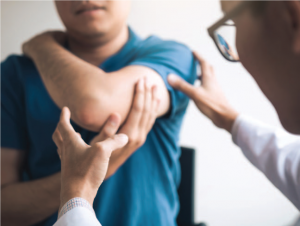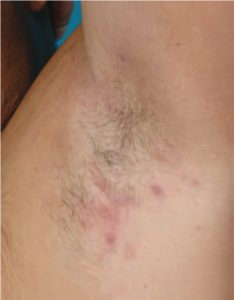An uptick in HS cases has the Trinitas Wound Center on alert.
By Mark Stewart

www.istockphoto.com
Healthcare consumers are always encouraged to seek second opinions if they have doubts or questions about a diagnosis or course of treatment. But we don’t always do that, do we? Especially not for the “small stuff”—for instance, conditions or maladies that don’t seem like a big deal at first. Unfortunately, small stuff can become a big deal, leaving us embarrassed and confused about whom to trust and where to find someone who’ll get it right. The Trinitas Center for Wound Healing and Hyperbaric Medicine sees more than its fair share of cases like this. The combination of a missed diagnosis and/or a patient’s frustration/fear/procrastination can result in the kinds of tough cases that Dr. Michael Zaboski, Medical Director of the Wound Center, encounters almost every day.
Recently, Dr. Zaboski noticed an uptick in the number of patients presenting with advanced cases of Hydradenitis Suppurativa—HS, for short—and it has him puzzled and concerned. “We had four active cases here in February, and each individually had been chronically ill for years,” he says. “That may not seem like a lot, but in my entire career here I’ve seen maybe 15 or 20.”
HS is a painful and unsightly skin condition for which there is currently no cure. However, it is treatable and manageable when caught early. The problem is that some doctors, including experienced dermatologists, do not recognize HS in its early stages, leading to misdiagnosis.

BMC Dermatology
HS outbreaks occur when the tiny sebaceous gland, which opens into a hair follicle and secretes “lubricant” for the hair and skin, does not produce properly and becomes blocked, creating a small, painful bump. These bumps occur in clusters near apocrine (sweat) glands, most commonly in the underarm and groin areas—including the gluteal, perineal and sacral regions—under the breasts and occasionally on the neck. HS may look like a bad case of acne at first, but despite the fact that it frequently starts in a person’s late teens or early 20s, it’s not acne at all.
“Hydradenitis Suppurativa ranges from a field of dark red boils or painful bumps in the underarm or private areas—which can be mistaken for acne—to more severe bumps that form sinuses that connect and spread, almost like a prairie dog field,” Dr. Zaboski explains, noting that these correspond to Class 1 and 2 on the Hurley scale—a severity assessment tool developed by dermatologist H.J. Hurley in the 1980s. “Class 3 is when these sinuses become confluent with large bags of pus and open sores and lesions. For the majority of HS patients, the condition is painful and hygienically difficult. It’s embarrassing and disfiguring.”
Most cases of HS are caught early and treated. However, when the Wound Center sees HS patients, they tend to be undiagnosed—or have not responded to dermatological treatment. Others come to the Emergency Department with an abscess, having no idea what the cause is.

Hidradenitis Awareness
“These cases can be extraordinarily advanced,” says Dr. Zaboski. “I have treated two young men, both in their 20s, who have no job and didn’t go to college, and blamed it on the disease. They were basically unable to function. It was too painful to walk and too painful to sit. Another man came to us with a quarter of his body area covered with lesions and had almost no normal skin from his waist all the way down his thighs. He’d had this for five years.”
HS is associated with several comorbidities, including obesity, diabetes, high cholesterol and hypertension (and often a combination of two or more). As diabetes and obesity increase in the population, so too will HS. There also appears to be a strong family component. Not surprisingly, depression, is common with this disorder.
Although there is no cure for HS, many patients respond well to Metformin, a drug that controls blood sugar. In the past, many HS patients had their boil-like bumps lanced, but incision and drainage simply prolonged the disease and also caused scarring. Steroid injections into the lesions can quiet the disease until other medicines kick in. Treatment is a long-term proposition, which typically involves anti-inflammatories and antibiotics until there is improvement. The goal is to stabilize patients medically and, if they haven’t improved, refer them for a surgical procedure, which goes under the skin to remove glandular tissue. This can get very complicated and may involve skin grafts and plastic surgery.
“The earlier we treat it, the better,” says Dr. Zaboski. “Also, a recent study suggests that large-scale weight loss may lead to a cure, so bariatric surgery may be an option. And HS can go into remission. Even in those instances, however, it requires chronic maintenance to prevent it from flaring up and getting worse.”









